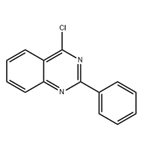- 4-CHLORO-2-PHENYLQUINAZOLINE
-

- $0.00 / 1kg
-
2022-10-20
- CAS:6484-25-9
- Min. Order: 1kg
- Purity: 98%
- Supply Ability: According to customer requirements
|
| | 4-CHLORO-2-PHENYLQUINAZOLINE Basic information |
| | 4-CHLORO-2-PHENYLQUINAZOLINE Chemical Properties |
| Melting point | 124-126 °C(lit.) | | Boiling point | 383.11°C (rough estimate) | | density | 1.285 | | refractive index | 1.5749 (estimate) | | storage temp. | under inert gas (nitrogen or Argon) at 2–8 °C | | form | Crystalline Powder | | pka | 0.67±0.30(Predicted) | | color | Slightly yellow to yellow | | InChIKey | OBHKONRNYCDRKM-UHFFFAOYSA-N | | CAS DataBase Reference | 6484-25-9(CAS DataBase Reference) |
| Hazard Codes | Xi | | Risk Statements | 36/37/38 | | Safety Statements | 37/39-26 | | WGK Germany | 3 | | HS Code | 29339980 |
| | 4-CHLORO-2-PHENYLQUINAZOLINE Usage And Synthesis |
| Chemical Properties | slightly yellow to yellow crystalline powder | | Uses | 4-Chloro-2-phenylquinazoline can be involved in the synthesis of biologically active molecules including: Nitrotriazole amines or nitroimidazole amines for use as antitrypanosomal activity and mammalian cytotoxicity. | | Uses | Reactant involved in the synthesis of biologically active molecules including:
- Nitrotriazole amines or nitroimidazole amines for use as antitrypanosomal activity and mammalian cytotoxicity
- Quinazoline-containing piperazinylpyrimidine derivatives with antitumor activity
- Quinazoline substituted cyclopentane as HCV NS3/4A protease inhibitors
- Quinazolines with antibacterial and antitumor activity
- Aurora inhibitor MK-0457
Reactant involved in Suzuki-Miyaura cross-coupling and catalyst-free / base-free water promoted nucleophilic aromatic substitution | | Synthesis Reference(s) | Journal of the American Chemical Society, 68, p. 1299, 1946 DOI: 10.1021/ja01211a055 | | Synthesis | General procedure for the synthesis of 4-chloro-2-phenylquinazoline from 4-hydroxy-2-phenylquinazoline: 4-hydroxy-2-phenylquinazoline (10 mmol) was mixed with phosphorochloridic acid (10 mL) and the reaction was stirred under reflux conditions for 9 hours. After completion of the reaction, the solvent was removed by distillation under reduced pressure. Ice water was added to the residue and neutralized with ammonium hydroxide until a precipitate was formed, followed by filtration to collect the precipitate. The product 4-chloro-2-phenylquinazoline (7) was purified by recrystallization from ethanol to give a brown solid in 68% yield. The structure of the product was determined by 1H NMR (500 MHz, DMSO-d6) δ 8.19-8.12 (m, 3H), 7.90-7.85 (m, 2H), 7.67-7.62 (m, 1H), 7.61-7.55 (m, 3H) and 13C NMR (126 MHz, DMSO-d6) δ 161.80, 153.93, 146.17, 135.15, 132.29, 131.09, 128.78, 128.50, 127.31, 126.21, 125.70, 120.75 for confirmation. | | References | [1] Medicinal Chemistry Research, 2012, vol. 21, # 7, p. 1199 - 1206
[2] Acta Chimica Hungarica, 1983, vol. 113, # 3, p. 247 - 256
[3] Organic Letters, 2016, vol. 18, # 9, p. 2150 - 2153
[4] Bioorganic and Medicinal Chemistry, 2011, vol. 19, # 6, p. 1987 - 1998
[5] Bioorganic and Medicinal Chemistry, 2013, vol. 21, # 24, p. 7858 - 7873 |
| | 4-CHLORO-2-PHENYLQUINAZOLINE Preparation Products And Raw materials |
|